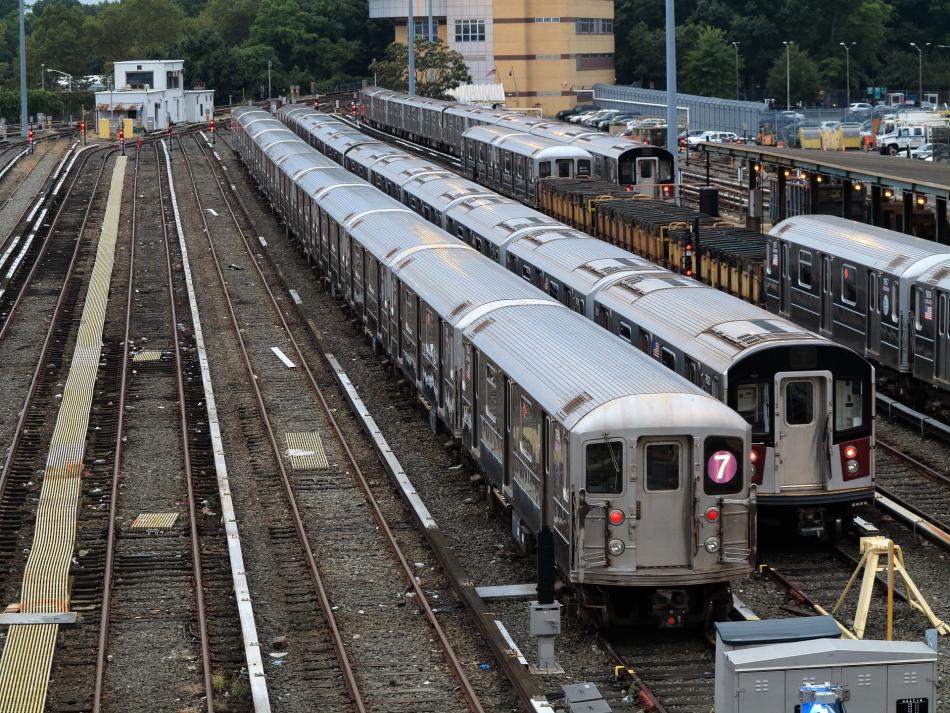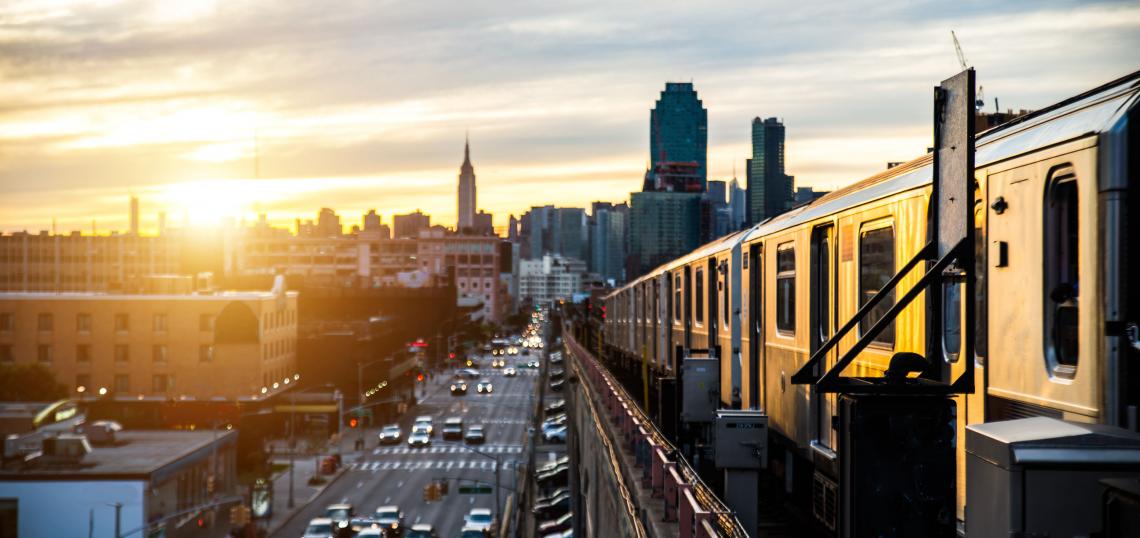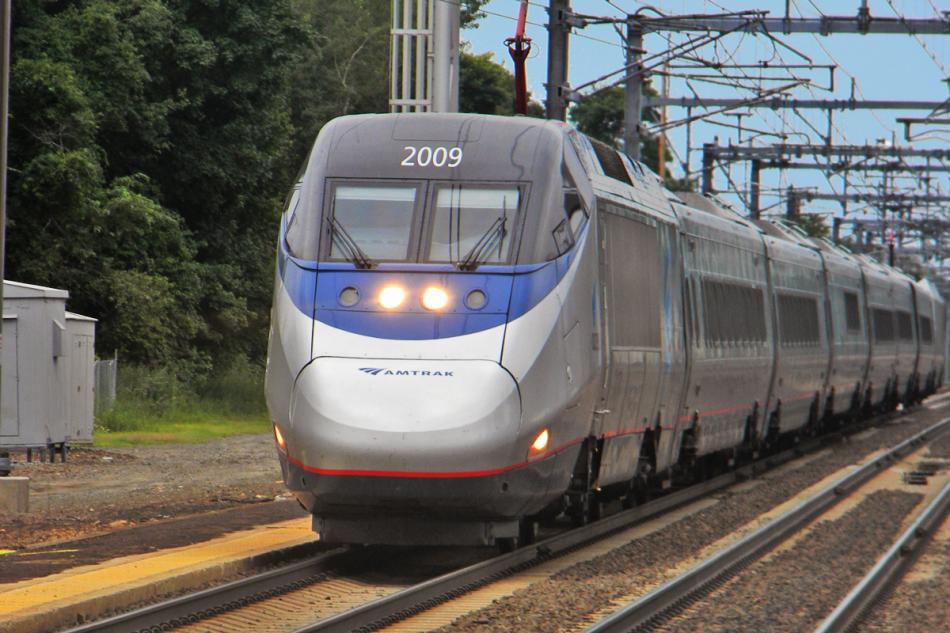This story was originally published on August 8, 2021 by THE CITY. Sign up here to get the latest stories from THE CITY delivered to you each morning.
The federal government could inject $550 billion in new spending on infrastructure projects around the country — but the MTA, the nation’s largest mass transit agency, stands to get about a 1.9% sliver of that.
The money would help jumpstart big-ticket capital projects such as the next phase of the Second Avenue Subway, the purchase of more electric buses and accessibility upgrades at more subway stations.
It’s a potential doubling of Federal Transit Administration funding, according to the MTA. But others pointed out regional transit network’s needs exceed the nearly $10.5 billion earmarked for the transit agency.
 Number 7 subway trains lined up in the Corona Yard near in Queens on September 6, 2017 in New York.Frank Romeo / Shutterstock
Number 7 subway trains lined up in the Corona Yard near in Queens on September 6, 2017 in New York.Frank Romeo / Shutterstock
“It’s not enough,” said Kathryn Wylde, head of the Partnership for New York City, which represents hundreds of business leaders that employ more than 1.5 million New Yorkers. “Patchwork is not going to do it.”
Nationwide, projects focused on highways, roads and bridges are set to receive $110 billion — the largest share of a federal infrastructure funding ratio that, for decades, has split 80/20 between drivers’ needs and public transit.
The bill passed the Senate last week as New York’s subway, bus and commuter rail systems struggle to regain riders, while traffic on bridges and tunnels around the city has surged to pre-pandemic levels.
Meanwhile, a plan that would fund mass transit upgrades through tolls on vehicles entering Manhattan south of 60th Street — and hopefully cut carbon emissions in the process — remains stalled.
Some say the new infrastructure bill continues traditional car-centric thinking even as climate change has become a more pressing issue.
“This is two steps forward and one step back,” Felicia Park-Rogers, director of regional infrastructure projects at the nonprofit Tri-State Transportation Campaign, told THE CITY. “Yes, it’s more dollars than ever before for transit, but it’s also more dollars than ever for highways and that’s just wrongheaded.”
Danny Pearlstein, policy director for the nonprofit Riders Alliance, noted “there’s a lot of new investments in highways that are going to induce a lot more driving and carbon emissions.”
Capital From the Capitol
The bipartisan bill aims to invest $39 billion in public transit systems, including the expected $10.5 billion for the MTA — marking a boost for the five-year capital program as the agency emerges from the pandemic.
The $51 billion MTA capital plan is focused on system maintenance, accessibility upgrades, the next phase of the Second Avenue Subway and four new Metro-North stations in the East Bronx.
The federal funds would also boost the amount of capital investment on buses with low or no emissions to $5.5 billion over five years as the MTA tries to shift its nearly 6,000-bus fleet to zero emissions by 2040.
Senate Majority Leader Chuck Schumer (D-Brooklyn) was key in the massive infrastructure bill’s passage.
“We thank Sen. Schumer for his steadfast support of the MTA and urge Congress to enact a final bill that addresses these pressing transit needs at a time when the MTA is needed more than ever to help fuel the region’s recovery,” Janno Lieber, the acting MTA CEO and chairperson said in a statement.
Making Up for What Was Lost
The MTA’s blueprint for the transit network was put on hold last June when a massive drop in ridership and tax revenue forced the agency to cover day-to-day operating expenses by diverting funds from long-term capital projects. The agency also took in billions of dollars in emergency federal aid.
“It’s like replenishing the MTA’s seed corn, because they really had to eat into their reserves and take emergency measures during the pandemic,” said Ben Fried of Transit Center, an advocacy and research organization.
“Think about all the extra borrowing they had to do, the way they cannibalized the capital budget to sustain operations, the hit they took to the new taxes that were supposed to fund the capital program,” he added.
An April report from State Comptroller Thomas DiNapoli said the capital program — whose half-decade priorities include re-signaling stretches of six subway lines and installing elevators at more than 60 stations — faced a nearly $3 billion hole.
‘Dramatic Things’
Some do see the federal money as an opportunity to think big.
Tom Wright, president of the Regional Plan Association, said the potential influx of money from the infrastructure bill potentially amounts to a “30- to 40-year alignment of the stars” after the city’s growth had stretched the transit system’s capacity in the years prior to the pandemic.
“We’ve repaired things here and there, we’ve extended a subway line, but it’s nothing on the scale of what we really needed,” Wright said. “Now suddenly, this is a generational moment when we realize we’ve used up the capacity in the existing system.”
While the federal infrastructure money is pegged to capital improvements and not operations, it could lessen pressure on paying off the MTA’s $48 billion debt.
“It puts the MTA in the position to do a lot of important work but falls short of affording the opportunity of a debt-free capital program,” Pearlstein said.
It also has marked $66 billion in passenger rail improvements, including the largest investment in Amtrak since it was founded half a century ago. The national railway system would get funding to reduce a maintenance backlog and to upgrade service along the Northeast Corridor between Boston and Washington D.C.
The plan could include money to help build a new rail tunnel in the Hudson River.
“We’re still living off many investments made at the beginning of the last century,” Wright said. “This will be an opportunity to do dramatic things.”
THE CITY is an independent, nonprofit news organization dedicated to hard-hitting reporting that serves the people of New York








